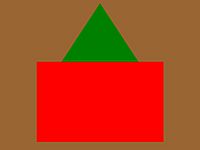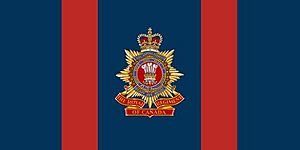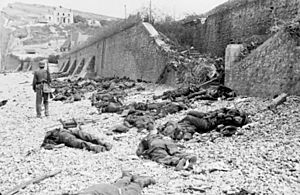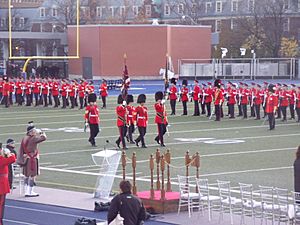The Royal Regiment of Canada facts for kids
Quick facts for kids The Royal Regiment of Canada |
|
|---|---|
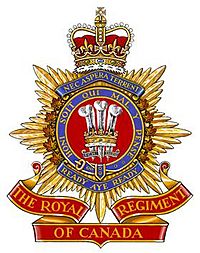
Badge of the regiment
|
|
| Active | 1862–present |
| Country |
|
| Branch | Canadian Army |
| Type | Infantry |
| Size | One Battalion |
| Part of | 32 Canadian Brigade Group |
| Garrison/HQ | Fort York Armoury, Toronto |
| Nickname(s) | Royals |
| Motto(s) | |
| March |
|
| Commanders | |
| Commanding officer | LCol Joseph Nonato |
| Regimental sergeant major | CWO Darryl Chambers |
| Colonel-in-chief | The Prince of Wales |
The Royal Regiment of Canada is an infantry regiment in the Canadian Army. It is based in Toronto, Ontario. This regiment is part of the 4th Canadian Division's 32 Canadian Brigade Group.
The soldiers of the Royal Regiment of Canada wear a special uniform for ceremonies. It includes a bright red jacket called a scarlet tunic and a tall fur hat called a bearskin. This uniform is similar to the one worn by the British Army's Grenadier Guards. The plume (feather) on their hat is red over white.
Contents
History of the Royal Regiment
The Royal Regiment of Canada has a long and interesting history. It was formed by combining different military groups over the years.
How the Royal Grenadiers Started
The story of the regiment began on December 21, 1861. It started in Toronto as "The Toronto Engineers and Mechanics Rifle Corps." Over time, its name changed several times:
- March 14, 1862: 10th Battalion Volunteer Militia Rifles, Canada
- November 21, 1862: 10th Battalion Volunteer Militia (Infantry), Canada
- April 10, 1863: Tenth or "Royal Regiment of Toronto Volunteers"
- August 5, 1881: 10th Battalion "Royal Grenadiers"
- May 8, 1900: 10th Regiment "Royal Grenadiers"
- May 1, 1920: Royal Grenadiers
During the First World War, this group was known as the 123rd Battalion, Royal Grenadiers. They trained many soldiers and officers for other Canadian battalions.
The Toronto Regiment's Beginning
Another important part of the regiment's history is the Toronto Regiment. It began on May 1, 1920, also in Toronto. This group was mainly formed from the 3rd Canadian Infantry Battalion, which fought in the First World War.
Forming The Royal Regiment of Canada
On December 15, 1936, the Royal Grenadiers and the Toronto Regiment joined together. They were first called "The Royal Regiment of Toronto Grenadiers." Then, on February 11, 1939, they were renamed "The Royal Regiment of Canada."
Later, on November 7, 1940, a second battalion (a group of soldiers) was created. This 2nd Battalion stayed in Canada to support the main regiment serving overseas.
Honoring Past Battalions
The Royal Regiment of Canada keeps alive the memory of several battalions that fought in the First World War. This is called "perpetuation." These include:
- 3rd Battalion (Toronto Regiment), CEF
- 58th Battalion, CEF
- 123rd Battalion (Royal Grenadiers), CEF
- 124th Battalion (Governor General's Body Guard), CEF
- 170th Battalion (Mississauga Horse), CEF
- 204th Battalion (Beavers), CEF
Battles and Operations
The Royal Regiment of Canada has taken part in many important events throughout history.
Fenian Raids (1866)
The 10th or Royal Regiment of Toronto Volunteers was called to action in 1866. They served on the Niagara frontier, helping to protect the border during the Fenian Raids.
North West Rebellion (1885)
In 1885, the 10th Regiment, Royal Grenadiers, sent soldiers to help in the North West Rebellion. They were part of Middleton's column and served until July 1885.
South African War (1899–1900)
During the South African War, members of the 10th Battalion Royal Grenadiers volunteered to join the 2nd (Special Service) Battalion, Royal Canadian Regiment of Infantry.
First World War (1914–1918)
On August 6, 1914, soldiers from the 10th Regiment Royal Grenadiers began local protection duties.
The 3rd Battalion (Toronto Regiment), CEF was formed on August 10, 1914. They went to Great Britain and then to France in February 1915. They fought as part of the 1st Infantry Brigade until the war ended.
The 58th Battalion, CEF, was formed on April 20, 1915. They arrived in France in February 1916 and fought as part of the 9th Infantry Brigade. Their story is told in the book "Second to None."
The 123rd Battalion (Royal Grenadiers), CEF, was formed on December 22, 1915. They became a pioneer battalion (soldiers who build and repair things) in January 1917. They served in France until May 1918, helping to form new engineering battalions. Their history is in the book "One-Two-Three."
The 124th Battalion (Governor General's Body Guard), CEF, also formed on December 22, 1915, became a pioneer battalion in January 1917. They served in France until May 1918, helping to form more engineering battalions.
Other battalions, like the 170th Battalion (Mississauga Horse), CEF and the 204th Battalion (Beavers), CEF, were formed to provide reinforcements for Canadian forces fighting overseas. Their soldiers were later absorbed into other units.
Second World War (1939–1945)
On September 1, 1939, the Royal Regiment of Canada was called to active service. They went to Iceland for duty in June 1940, then moved to Great Britain in October 1940. The 1st Battalion of the regiment took part in the famous Dieppe Raid on August 19, 1942.
They returned to France on July 7, 1944, as part of the 4th Infantry Brigade. They continued fighting in North-West Europe until the war ended. The 1st Battalion was disbanded on December 31, 1945, and joined with the 2nd Battalion back home.
The Dieppe Raid: Blue Beach
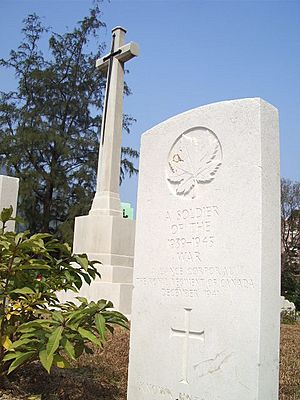
During the Dieppe Raid, the Royal Regiment of Canada landed at a place called Puys, also known as Blue Beach. They were supposed to land under the cover of darkness and smoke screens. However, they were delayed, and the smoke had cleared, giving away their surprise.
German defenders were ready and waiting. As soon as the Canadians reached the shore, they were trapped against a seawall. They faced heavy machine-gun fire from the cliffs above. The Royals suffered many losses: out of 556 men, 200 were killed, and 264 were captured.
Battle Honours
Battle honours are special awards given to military units for their bravery and success in battles. The Royal Regiment of Canada has many battle honours, which are displayed on their regimental colours (flags).
Here are some of the major battles and campaigns they are recognized for:
- North West Rebellion: Fish Creek, Batoche, North West Canada, 1885
- South African War: South Africa, 1899–1900
- First World War: Ypres, 1915, '17, Festubert, 1915, Mount Sorrel, Somme, 1916, Arras, 1917, Vimy, 1917, Passchendaele, Amiens, Hindenburg Line, Pursuit to Mons, France and Flanders, 1915–'18
- Second World War: Dieppe, Bourguébus Ridge, Faubourg de Vaucelles, Verrières Ridge–Tilly-la-Campagne, Falaise, The Scheldt, The Rhineland, The Hochwald, Xanten, Twente Canal, Groningen, North-West Europe, 1942, 1944–1945
- South-West Asia: Afghanistan
The Regimental Band
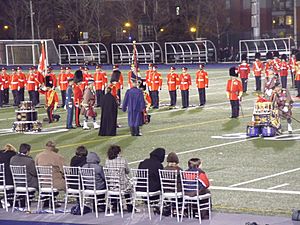
The Band of The Royal Regiment of Canada is the oldest military band in the Canadian Forces. It was formed in 1863 and is based at Fort York in Toronto. The band performs for many events, both in Canada and around the world.
Some of their special performances include:
- Playing for members of the Royal Family, like Queen Elizabeth II and Prince Charles.
- Performing for the United Nations in Cyprus.
- Playing at the Military Musical Pageant in London, England.
- Being the official band for veterans and officials during the 50th anniversary of the Dieppe Raid.
- Performing at the International Military Band Festival in Poland.
- Traveling across Canada, from Newfoundland to British Columbia, for various events.
The Royal Regiment of Canada Association
The Royal Regiment of Canada Association is a group made up of former members of the unit. Their main goal is to keep the spirit of friendship and teamwork alive among the regimental family. They meet regularly to stay connected. In 2008, they helped raise money to get enough traditional scarlet and blue uniforms for most of the regiment's members to wear for special ceremonies.
The Regimental Museum
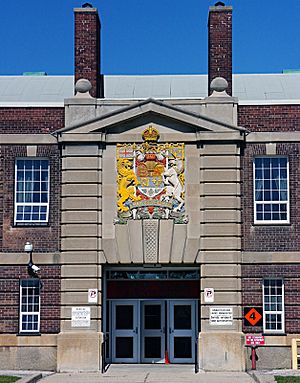 |
|
| Location | Fort York Armoury, 660 Fleet Street West, Toronto, Ontario, Canada |
|---|---|
| Type | Regimental Museum |
The Museum of The Royal Regiment of Canada works to preserve and show the history of the regiment. It is for both the soldiers and the public to learn from. The museum is located at the Fort York Armoury.
Inside, you can see many interesting items. These include old weapons, uniforms, medals, and photographs. They tell the story of the Royal Regiment of Canada and its earlier groups. These include the 10th Royal Grenadiers and several battalions from the First World War. The museum offers displays and tours for schools by appointment.
Alliances with Other Regiments
The Royal Regiment of Canada has special connections, or alliances, with other military regiments:
 United Kingdom – The Duke of Lancaster's Regiment (King's Lancashire and Border) (United Kingdom)
United Kingdom – The Duke of Lancaster's Regiment (King's Lancashire and Border) (United Kingdom) Australia – The Royal Victoria Regiment (Australia)
Australia – The Royal Victoria Regiment (Australia)
Fort York Armoury
The Fort York Armoury is the home of the Royal Regiment of Canada. It is located at 660 Fleet Street West, Toronto, ON M5V 1A9.
Order of Precedence
| Preceded by Les Voltigeurs de Québec |
Royal Regiment of Canada | Succeeded by The Royal Hamilton Light Infantry (Wentworth Regiment) |


